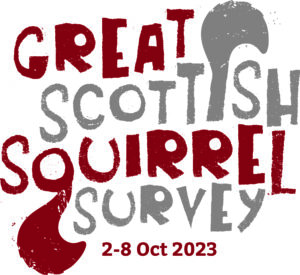
Red Squirrels in the National Park
An Interview with Felix Sanchez-Bishop, Conservation Officer for Saving Scotland’s Red Squirrels.
Saving Scotland’s Red Squirrels (SSRS) is a project led by the Scottish Wildlife Trust in partnership with the National Park and others, working to ensure red squirrels continue to be part of Scotland’s native wildlife. While 75% of the UK’s remaining red squirrels are found here, their numbers have fallen drastically in recent decades due to the spread of the invasive non-native grey squirrel.
In honour of National Red Squirrel Week and the fifth annual Great Scottish Squirrel Survey, we sat down with Conservation Officer for Argyll, the Trossachs and Stirlingshire, Felix Sanchez-Bishop, to find out more about the work of the project in the National Park:
- What are the main aims of your role, as Conservation Officer for Saving Scotland’s Red Squirrels within the National Park?
My remit covers Argyll, the Trossachs & Stirlingshire, much of which is within National Park. I work to defend the Highland Boundary Fault Line from grey squirrel incursion, protecting the existing red-only squirrel populations further north. The shores of Loch Lomond are a key route into these red-only squirrel populations, whilst the areas in the east and south of the National Park are priority areas for squirrelpox monitoring and ongoing control efforts.
- Why is it so important to carry out the work the project is undertaking?
The biggest threat to Scotland’s native red squirrel is the invasive non-native grey squirrel. Due to their size, higher reproductive rate, ability to live at higher densities and that some carrying squirrelpox virus (which does not affect them), when greys move into a new area, red squirrels can be completely replaced within 15 years, a rate up to 20 times faster when squirrelpox is present.
Red squirrels on the other hand are key to the health and regeneration of native woodlands, planting tree seeds when caching them in the ground and spreading the spores of fungi that trees rely on for healthy growth and disease resistance. Grey squirrels also bury tree seeds, but they also inflict damage on young trees through bark-stripping which, at high grey densities, will likely negate much of the benefit seen from seed dispersal and pose significant threats to our forests.
- Can you tell us a little bit more about what a typical day looks like for you working in the National Park?
Ever changing! When I get into the office I usually check for any new sightings submitted by members of the public on our Hub, if we have greys where they shouldn’t be that usually jumps to the top of the list! I’ll reach out directly to whoever reported the sighting or just get out on the ground myself. SSRS operates a trap loan scheme to remove greys from people’s gardens, and I spend my time between these and trapping in larger forests as well as supporting larger estates via the government Forestry Grant Scheme.
- What have some of the greatest successes of the project been so far?
One of our greatest achievements is halting the spread of grey squirrels further into the National Park Area. Additionally, recent data has shown a retraction of the grey squirrel range in key areas such as the east shores of Loch Lomond, Loch Voil and Loch Earn. Thanks to the efforts of both volunteers and staff across the region we are beginning to see signs of a recovery in red squirrel populations in some parts of the National Park and the wider region.
- What activities and actions will you be working on next?
This week is our Great Scottish Squirrel Survey. We are encouraging members of the public to share all squirrel sightings – both red and grey. As part of this I’ll be delivering talks and hosting a stall to chat to people about the work we are undertaking on Saturday at Balmaha Visitor Centre on the East shore of Loch Lomond – book your tickets!
The big event in our calendar is for next summer when we are hoping to do a Loch-wide grey squirrel removal from the islands on Loch Lomond. Because of existing stable populations of red squirrels on the north and eastern parts of the Loch this work could help us get within touching distance of native reds repopulating the islands (yes they can swim to them!).
- Why is the Great Scottish Squirrel Survey such an important event in the squirrel calendar, and how do the sightings collected contribute towards your work?
The Great Scottish Squirrel Survey is an important event for helping us to connect with members of the community who are so important in helping us carry out our work. We rely heavily on members of the public for sightings to be our eyes and ears and the sightings captured during the week provide us with a snapshot of red & grey distributions across the national park.
Sightings submitted throughout the year are key in informing and directing our strategic efforts day to day. More sightings give us a more complete picture of what is happening on the ground and can alert staff to situations where greys pose an immediate threat to the local red squirrel population.
- Finally, if people are interested in getting involved with the survey and red squirrel conservation efforts in the National Park, what opportunities are there and how should they get in touch with you?
Hub sightings are the easiest way to get involved. If they want to do more for red squirrels in the Park, we are always looking for volunteers, with a variety of roles both in person and online! Check out the volunteering section of our website for more information and opportunities!

The Great Scottish Squirrel Survey is taking place between the 2-8 October, and the project is encouraging everybody all over Scotland to report their sightings of both red and grey squirrels.

